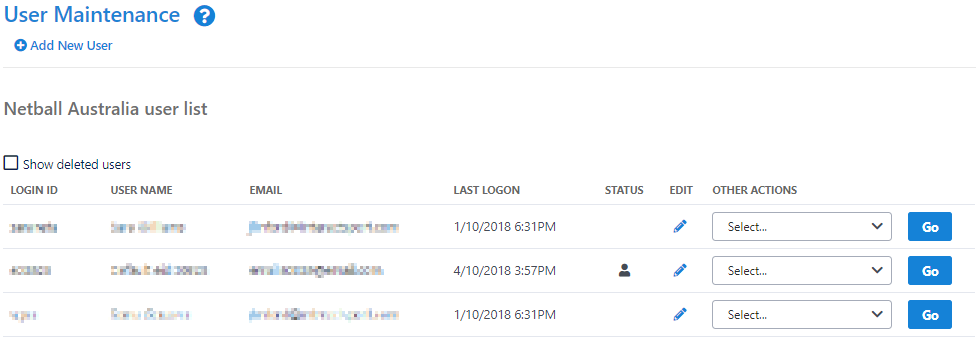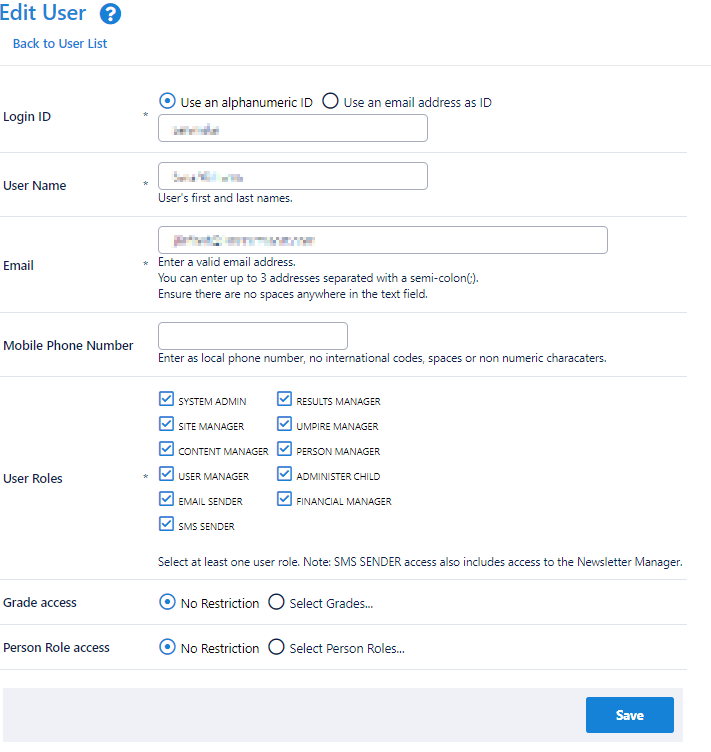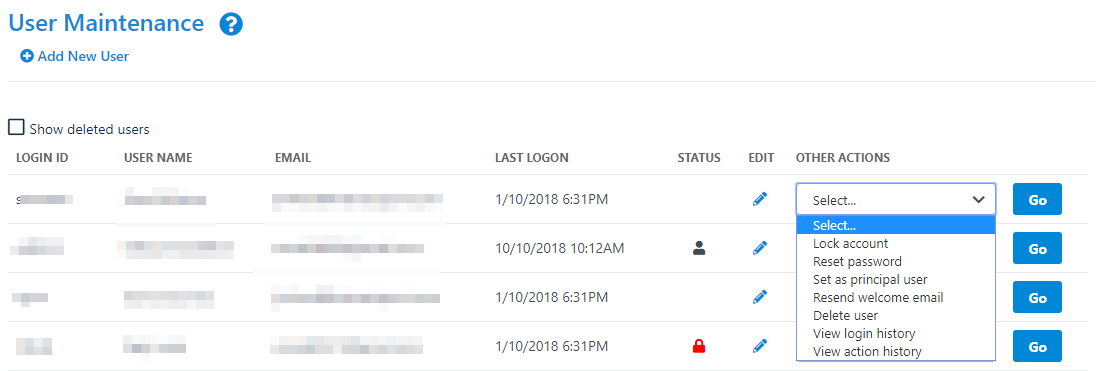A User is someone that is able to login to the
...
ResultsVault and/or SportzVault Administration web site to carry out certain administrative tasks.
A User Account can have one or more User Roles assigned to it, that gives the ability to carry out different tasks, and/or access different parts of the administration site. Any number of User Accounts can be created within an Organisation. For example, a Club may wish to set up a different User to enter Results for each of its teams' different Users to help maintain the website content.
Create or Edit User
The User Maintenance screen lists all Users currently created within the organisation.
To Edit a User, click the
...
Edit link next to the User's name
...
, or to Add a New User, click .
...
The Edit User screen will display.
...
Login ID * | This is the ID used to log in to the system.
|
|---|
...
|
...
|
...
|
...
|
...
|
...
|
...
|
...
|
...
|
...
|
...
| |
User Name * | Name of User. |
|---|---|
Email * | Valid email address of the User. You can enter up to 3 addresses separated with a semi-colon. Ensure there are no spaces entered between the email addresses and the semi-colon(s). For example: myaddress@example.com;anotheraddresss@example.com When creating a new User, optionally check the Send |
...
User welcome email checkbox that will email a welcome message to the new User containing the ID and Password, and in most cases, a PDF Getting started guide. | |
Mobile Phone Number | Mobile phone number of User. |
|---|
...
*Required field.
Roles of Admin Users
...
SYSTEM ADMIN |
|---|
...
High level system administration. | |
SITE MANAGER | Higher level website and competition related maintenance that is typically related to 'setup' or 'configuration' tasks |
|---|
...
, such as:
| |
CONTENT MANAGER | Website content related maintenance (e.g. create and maintain Html content, home page, News, Events, Slideshow Galleries). |
|---|
...
User MANAGER |
|---|
...
Create and maintain other Users.
| |||
EMAIL SENDER | Access to send email messages
| ||
|---|---|---|---|
SMS SENDER |
| ||
RESULTS MANAGER | Competition |
...
Results related maintenance (e.g. clubs: results and scores update, associations: match confirmation, exception reports etc). | |
MATCH OFFICIAL MANAGER | |
|---|---|
PERSON MANAGER | Creation, editing, deleting of person records - |
...
e.g. Players, Contacts, Umpires and tasks related to person records. |
ADMINISTER CHILD |
|---|
...
Managing competitions between other 'child' organisations to 'administer' a child organisation without requiring a separate login to that organisation. |
...
User with the role can 'administer' one of its participating clubs directly (from the dropdown list on the administration home page). See below for more |
FINANCIAL MANAGER |
|---|
...
|
...
|
| Note |
|---|
|
...
|
...
|
...
|
...
|
...
|
...
|
...
|
...
|
Grade Access for Admin Users
...
By default, a
...
User has access to all grades that are relevant to their organisation. This can be restricted as follows:
Click the Select Grades radio button
Select one or more grades from the Available
...
Grades list box
Click the Add button
A
...
User who has restricted grades assigned will only see their 'allowed' grades in any grade dropdown list (e.g. within the selector bar on most pages - in which case an asterisk * will appear next to the grade dropdown list to indicate this)
...
.
Restricted Grades are assigned typically by:
A Club restricting a User to a single Grade so that he/she can only enter results for that Grade (e.g. 'team managers').
An Association restricting a User to a single Grade so that he/she can only review/lock results for that Grade.
| Note |
|---|
If new grades are added to the |
...
Organisation (e.g. in a new season), any |
...
Users that have the Select Grades radio button |
...
selected will not automatically have access to the new grade, and each affected |
...
User Account will need to be edited to add the |
...
Grade (if applicable). Users that have |
...
the radio button selected automatically have access to all |
...
Grades, including new ones that are added from time to time. |
- A club restricting a user to a single grade so that he/she can only enter results for that grade (e.g. 'team managers')
- An association restricting a user to a single grade so that he/she can only review/lock results for that grade
Person Role Access
By default, a
...
User has access to all person records within their
...
Organisation irrespective of the Person Roles (
...
e.g. PLAYER, CONTACT)
...
that the person record has. This can be restricted as follows:
- Click the Select Person Roles radio button.
- Select one or more Person Roles from the Available Person Roles
...
- list.
- Click the Add button.
| Note |
|---|
|
...
|
...
|
...
|
...
|
...
A
...
User who has restricted Person Roles assigned will not be able to access any person record for editing or viewing which does not hold at least one of their allowed roles. These records would also have personal information obscured in any person list for that
...
User.
Examples:
User's 'allowed' Person Roles | Person has these roles | Does |
|---|
...
User have access | ||
|---|---|---|
ALL PLAYER ROLES | PLAYER:SENIOR, COACH:SENIOR | YES |
PLAYER:SENIOR | PLAYER:SENIOR, COACH:SENIOR | YES |
PLAYER:JUNIOR | PLAYER:SENIOR, COACH:SENIOR | NO |
ALL PLAYER ROLES | (No roles) | NO |
ALL PLAYER ROLES,NO ROLES | (No roles) | YES |
| Note |
|---|
...
Grade and Person Role |
...
takes precedence over User Roles. A |
...
User will still require the applicable |
...
User role (e.g. RESULTS MANAGER or PERSON MANAGER) in order to access various |
...
Admin Pages. |
More information about administering child organisations
When a
...
User administers a
...
Child Organisation:
User
...
Roles EMAIL_SENDER, SMS_ SENDER, FINANCIAL_MANAGER, CONTENT_ MANAGER are
...
rendered inactive. For example, the
...
User will not be able to send an email while administering the child organisation.
Any grade restrictions
...
that User has remain active.
Grades are further restricted to the grades managed by the
...
User's
...
Organisation.
For example,
...
Club C belongs to
...
Association A
...
(that has
...
Grades G1 and G2) and
...
Association B
...
(that has
...
Grades G3 and G4). Club A participates in
...
Grades G1, G2, G3 and G4. A
...
User from
...
Association A administering
...
Club C will only have access to
...
Grades G1 and G2.
A
...
User with 'unrestricted' Person Role access can only access PLAYER type roles in the child organisation.
A
...
User with restrictions on Person Role access can only access the PLAYER type roles in the
...
Child Organisation that are in their 'allowed' list (and no other types of roles).
When the
...
User administers their own
...
Organisation, all their normal access is restored.
| Note |
|---|
The above restrictions do not apply for any |
...
User that has the special SYSTEM ADMIN User role. |
More actions
...
...
Delete User
...
- You cannot delete yourself or the Principal User.
- If the account has been logged in to, it may not be possible to completely remove the account. In this case it is marked as deleted.
These sort of deleted accounts can be displayed in the User List by checking the Show Deleted accounts check box.
...
Restore User
...
Note: Display deleted user accounts in the User List by checking the Show Deleted users checkbox.
Select the UnDelete User action and click Go Accounts that were completely removed when initially deleted (see above) cannot be restored.
...
Resend welcome email
...
When a user account is created, an email is sent containing the user's login details, information about how to log in, and in most cases a
PDF 'Getting started guide'. This email can be resent to the user at any time.
- Select the Resend welcome email action and click Go
...
for System Admin Users
| Lock/unlock account | A User who has more than |
|---|
...
5 consecutive login failures will be automatically locked, and cannot log in to the system. This is to prevent hacking attempts. |
...
An Account can be |
...
locked manually in order to temporarily disable a login, without deleting the |
...
Account. To lock an |
...
Account:
|
...
|
...
|
...
To unlock |
...
an Account:
|
...
|
...
|
...
|
...
|
| Reset a |
|---|
...
| password | You can reset a User's password |
|---|
...
, regardless of whether or not the |
...
User Account is locked (although typically you would |
...
only |
...
do this on a locked |
...
Account).
|
...
The User password will be |
...
changed to a |
...
randomly generated password, that will be emailed to the |
...
User. |
...
The |
...
User will need to change that password the next time they login. |
...
| Set as principal User | Select the Set as Principal |
|---|
...
| User action and click Go. | |||
Resend welcome email | When a User Account is created, an email is sent containing the User's login details, information about how to log in, and optionally a PDF 'Getting started guide'. This email can be re-sent to the User at any time. Select the Resend welcome email action and click Go. | ||
|---|---|---|---|
| Delete/Undelete User | To delete a User Account:
Undelete a User Account:
| ||
View Login History | Show list of latest login attempts - success/failure, time stamps and IP address. | ||
View Action |
...
History | Show list of latest action attempts/pages views. |
|---|
Relevant pages
...








